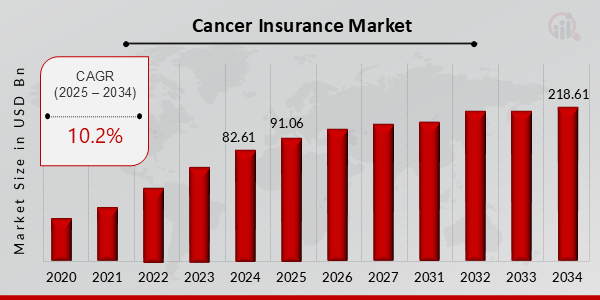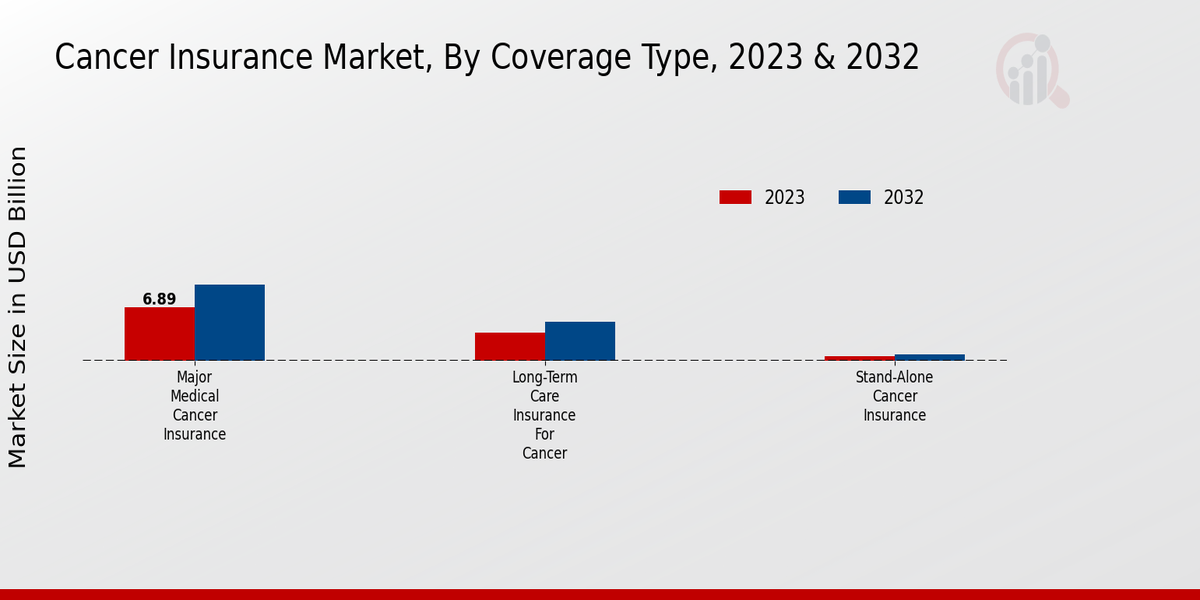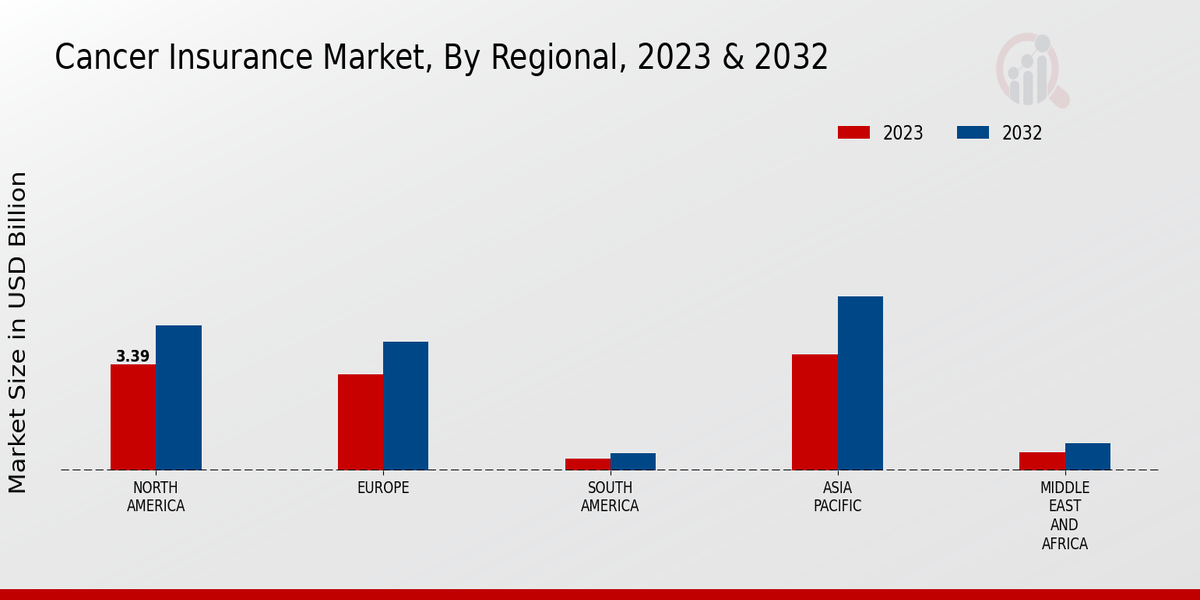Global Cancer Insurance Market Overview
Cancer Insurance Market Size was estimated at 82.61 (USD Billion) in 2024. The Cancer Insurance Market Industry is expected to grow from 91.06 (USD Billion) in 2025 to 218.61 (USD Billion) till 2034, exhibiting a compound annual growth rate (CAGR) of 10.2% during the forecast period (2025 - 2034).
Key Cancer Insurance Market Trends Highlighted
Key market drivers in the Cancer Insurance market include rising cancer incidence rates, growing awareness about cancer prevention and early detection, and increasing disposable income in emerging economies. The market is also driven by the increasing availability of advanced cancer treatments and the rising cost of healthcare. Opportunities to be explored or captured in the Cancer Insurance market include the development of new cancer treatments and technologies, the expansion of cancer insurance coverage in emerging markets, and the integration of cancer insurance with other health insurance products. Trends in recent times include the increasing use of telemedicine for cancer care, the development of personalized cancer treatments, and the growing adoption of value-based care models.
Major market players in the Cancer Insurance market include Allianz, AXA, Bupa, Cigna, and Zurich Insurance. These players are focusing on expanding their product offerings, increasing their geographic reach, and improving their customer service. The market is also seeing the emergence of new players, especially in emerging markets.

Source: Primary Research, Secondary Research, MRFR Database and Analyst Review
Cancer Insurance Market Drivers
Rising Cancer Incidence and Prevalence
Cancer is a leading cause of morbidity and mortality worldwide, with an estimated 19.3 million new cases and 10.0 million deaths in 2020. The incidence and prevalence of cancer are expected to continue to rise in the coming years due to factors such as aging populations, unhealthy lifestyles, and environmental pollution. This is driving demand for cancer insurance as individuals seek financial protection against the high costs of cancer treatment.
Increasing Awareness of Cancer Insurance
There is a growing awareness of cancer insurance among individuals and families. This is due to factors such as increased media coverage of cancer, public health campaigns, and the efforts of insurance companies to promote cancer insurance products. As a result, more people are becoming aware of the benefits of cancer insurance and are purchasing policies to protect themselves against the financial risks of cancer.
Government Initiatives
Governments in many countries are implementing initiatives to promote cancer insurance. These initiatives include tax incentives, subsidies, and public awareness campaigns. For example, the Indian government launched the Pradhan Mantri Jeevan Jyoti Bima Yojana (PMJJBY) in 2015, which provides life insurance coverage to individuals between the ages of 18 and 50 for a premium of just Rs. 330 per year. The PMJJBY also includes coverage for cancer treatment up to Rs. 2 lakh.
Cancer Insurance Market Segment Insights
Cancer Insurance Market Coverage Type Insights
The Cancer Insurance Market is segmented by Coverage Type into Major Medical Cancer Insurance, Long-Term Care Insurance for Cancer, and Stand-Alone Cancer Insurance. Major Medical Cancer Insurance is the most common type of cancer insurance, and it covers the costs of medical treatment for cancer, such as surgery, chemotherapy, and radiation therapy. Long-Term Care Insurance for Cancer covers the costs of long-term care for cancer patients, such as nursing home care or home health care. Stand-Alone Cancer Insurance is a type of cancer insurance that is not tied to a specific health insurance plan. The growth of the market is attributed to the increasing incidence of cancer worldwide, the rising cost of cancer treatment, and the growing awareness of cancer insurance.
Major Medical Cancer Insurance is the largest segment of the Cancer Insurance Market, and it is expected to continue to be the largest segment over the forecast period. The growth of this segment is attributed to the increasing number of people being diagnosed with cancer and the rising cost of cancer treatment. Long-Term Care Insurance for Cancer is the fastest-growing segment of the Global Cancer Insurance Market, and it is expected to grow at a CAGR of 4.5% over the forecast period. The growth of this segment is attributed to the increasing number of cancer survivors who need long-term care.
Stand-Alone Cancer Insurance is the smallest segment of the Cancer Insurance Market, and it is expected to grow at a CAGR of 3.0% over the forecast period. The growth of this segment is attributed to the increasing awareness of cancer insurance and the growing number of people who are choosing to purchase cancer insurance as a supplement to their other health insurance coverage.
Cancer Insurance Market, by Coverage Type 2023 & 2032

Source: Primary Research, Secondary Research, MRFR Database and Analyst Review
Cancer Insurance Market Premium Tier Insights
The premium tier segment of the Cancer Insurance Market is differentiated into two sub-segments, including Individual and Group applications. The Individual plans, as their name implies, are originally addressed to individuals and families on a contractual basis for a specific range of persons. At the same time, the Group sub-segment is logically oriented toward the employers or different types of organizations that are capable of buying a corporate agreement of the whole insurer’s staff or members. It seems logical that the Individual premium tier segment generates more revenue shares in the Cancer Insurance Market.
This is mainly predetermined by an increasing rate of the global population’s awareness concerning the probability of contracting oncologic diseases and enlarging affordability of individual health insurance coverage. Moreover, the appearance of middle-class and high-net-worth individuals also fuels the revenue shares of the discussed segment. In contrast to the abovementioned tendencies, the Group premium tier segment will glide along with a moderate rate of increasing its yield as a part of the global market within the observed period.
The main factors influencing these processes are compulsory demand for employee benefits among corporates and a rather high degree of necessity for comprehensive health insurance by the employers’ side.
Cancer Insurance Market Cancer Stage Insights
The Cancer Stage segment plays a crucial role in shaping the dynamics of the Cancer Insurance Market. It is categorized into three primary sub-segments: Early Stage, Advanced Stage, and End Stage. Each stage presents distinct market characteristics, driving the overall industry growth. Early Stage cancer insurance caters to individuals diagnosed with cancer in its initial stages. With advancements in screening and early detection methods, the prevalence of early-stage cancer cases is rising, leading to a growing demand for insurance coverage.
This segment holds a significant share of the Global Cancer Insurance Market revenue, with a CAGR of approximately 4.5% projected for 2024-2032. Advanced Stage cancer insurance targets individuals diagnosed with cancer that has progressed beyond the early stages. The increasing incidence of advanced-stage cancer cases, coupled with the rising cost of treatment, is driving the demand for comprehensive insurance plans. This segment is expected to witness a steady growth rate of around 3.8% during the forecast period. End Stage cancer insurance provides coverage for individuals with advanced or terminal cancer.
While the market size for this segment is smaller compared to the other two, it is projected to grow at a moderate pace due to the increasing life expectancy of cancer patients and the rising need for palliative care. The segmentation of the Cancer Insurance Market based on the Cancer Stage enables insurers to tailor their products and services to meet the specific needs of individuals at different stages of the disease. This customization helps drive market growth and enhances the overall accessibility and affordability of cancer insurance coverage.
Cancer Insurance Market Payout Type Insights
The Cancer Insurance Market is segmented by payout type into lump sum, periodic payments, and expense reimbursement. Lump sum payouts provide a one-time payment to the policyholder upon diagnosis of cancer. Periodic payments provide regular payments over a period of time, typically until the policyholder reaches a certain age or the policy expires. Expense reimbursement payouts cover the costs of cancer treatment, such as medical bills, hospital stays, and transportation costs. In 2023, the lump sum payout segment accounted for the largest share of the Global Cancer Insurance Market revenue, with a market share of approximately 55%.
The periodic payments segment is expected to grow at the highest CAGR during the forecast period, with a CAGR of 4.2%. The expense reimbursement segment is expected to account for the smallest share of the market in 2032, with a market share of approximately 20%. The growth of the periodic payments segment is attributed to the increasing popularity of cancer insurance policies that provide long-term financial protection. The expense reimbursement segment is expected to grow at a slower pace due to the high cost of cancer treatment and the increasing availability of government-sponsored health insurance programs.
Cancer Insurance Market Regional Insights
Regionally, North America is expected to account for the largest revenue share in the Cancer Insurance Market, followed by Europe, APAC, South America, and MEA. The high prevalence of cancer and increasing awareness about cancer insurance are driving the market growth in North America. Europe is another major market for cancer insurance, with a strong presence of private health insurance companies offering cancer insurance policies. The APAC region is expected to witness significant growth in the cancer insurance market, driven by rising disposable income and increasing awareness about cancer. South America and MEA are emerging markets for cancer insurance, with growing demand for insurance products.
Cancer Insurance Market, by Region 2023 & 2032

Source: Primary Research, Secondary Research, MRFR Database and Analyst Review
Cancer Insurance Market Key Players And Competitive Insights:
The major players in the Cancer Insurance Market industry are continuously striving to gain a competitive edge by investing heavily in the research and consummation segment, pursuing innovations and expanding their product portfolio. Leading companies are also concentrating on establishing strategic collaborations, developing mergers and acquisitions, and expanding their market presence, and gaining access to new markets. The development of the Cancer Insurance Market is driven by the increasing prevalence rate of cancer, the rapid pace of growth of healthcare costs, and the heightened level of public awareness of the necessity to deal with financial protection against any kind of cancer-related expenses. The Cancer Insurance Market Competitive Landscape is projected to remain quite comfortable in the years to come when companies are likely to pursue their business objectives through a combination of product differentiation, expansion of value-added-based services, and ongoing price competition.
Currently, the position of one of the leaders in the market is held by Aetna, a global provider of healthcare and insurance services. The company offers a broad range of cancer insurance solutions, both individual and group policies, designed to cater to all types of cancer-related expenses, including diagnostics, treatments, and costs related to recovery and recuperation. The company’s position is strongly supported by innovations in every segment of its operations, a strong focus on the needs of the customers, and a remarkably strong record of financial achievements.
Allianz is one of the key contenders in the cancer insurance market as a global operating provider of a broad range of financial services. The company provides the entire spectrum of tailored cancer insurance solutions, and its position is supported by a global market presence, strong brand recognition, and a diversified portfolio of company products. The company’s activities are strongly supported by a commitment to grow a diverse portfolio of high-quality, comprehensive insurance services and a strong focus on client-tailored solutions.
Key Companies in the Cancer Insurance Market Include:
- Allianz
- Generali
- Ping An Insurance
- Sun Life Financial
- Munich Re
- Zurich
- Swiss Re
- Prudential
- Sompo Japan Nipponkoa
- New York Life
- Tokio Marine
- AXA
- AIA
- Cigna
- MetLife
Cancer Insurance Industry Developments
The Cancer Insurance Market is projected to reach USD 15.72 billion by 2032, growing at a CAGR of 3.92% from 2023 to 2032. The increasing incidence of cancer and the rising cost of cancer treatment are driving the growth of the market. Moreover, the growing awareness of cancer insurance and the government initiatives to promote cancer insurance are also contributing to the market growth.
Recent news developments in the Cancer Insurance Market include the launch of new cancer insurance products by major insurance companies and the expansion of cancer insurance coverage by governments. For instance, in 2023, HDFC Life launched a new cancer insurance plan that provides coverage for up to 50 types of cancer and offers a lump sum payout upon diagnosis.
Additionally, the government of India announced plans to expand the coverage of its Ayushman Bharat health insurance scheme to include cancer insurance. These developments are expected to further drive the growth of the Global Cancer Insurance Market in the coming years.
Cancer Insurance Market Segmentation Insights
Cancer Insurance Market Coverage Type Outlook
- Major Medical Cancer Insurance
- Long-Term Care Insurance for Cancer
- Stand-Alone Cancer Insurance
Cancer Insurance Market Premium Tier Outlook
Cancer Insurance Market Cancer Stage Outlook
- Early Stage
- Advanced Stage
- End Stage
Cancer Insurance Market Payout Type Outlook
- Lump Sum
- Periodic Payments
- Expense Reimbursement
Cancer Insurance Market Regional Outlook
- North America
- Europe
- South America
- Asia Pacific
- Middle East and Africa
|
Report Attribute/Metric
|
Details
|
|
Market Size 2024
|
USD 82.61 Billion
|
|
Market Size 2025
|
USD 91.06 Billion
|
|
Market Size 2034
|
USD 218.61 Billion
|
|
Compound Annual Growth Rate (CAGR)
|
10.2% (2025-2034)
|
|
Base Year
|
2024
|
|
Market Forecast Period
|
2025-2034
|
|
Historical Data
|
2020-2023
|
| Market Forecast Units |
USD Billion |
| Key Companies Profiled |
Allianz, Generali, Ping An Insurance, Sun Life Financial, Munich Re, Zurich, Swiss Re, Prudential, Sompo Japan Nipponkoa, New York Life, Tokio Marine, AXA, AIA, Cigna, MetLife |
| Segments Covered |
Coverage Type, Premium Tier, Cancer Stage, Payout Type, Regional |
| Key Market Opportunities |
Rising cancer incidence rates.Growing awareness of cancer prevention and treatment options.Increasing demand for personalized insurance coverage.Aging populationTechnological advancements in cancer diagnosis and treatment |
| Key Market Dynamics |
Rising cancer incidence.Growing awareness of cancer insurance.Increasing urbanization and sedentary lifestyles.Increasing disposable income and health consciousness.Government initiatives to promote cancer insurance. |
| Countries Covered |
North America, Europe, APAC, South America, MEA |
Frequently Asked Questions (FAQ) :
The Global Cancer Insurance Market is expected to reach a valuation of USD 82.61 Billion in 2024 and is projected to reach a valuation of USD 218.61 Billion by 2034, exhibiting a CAGR of 10.2% during the forecast period.
The increasing prevalence of cancer, rising healthcare costs, growing awareness about cancer insurance, and expanding government initiatives to support cancer patients are the primary factors driving the growth of the Global Cancer Insurance Market.
North America is expected to hold the largest market share in the Global Cancer Insurance Market due to the high prevalence of cancer, well-established healthcare infrastructure, and increasing adoption of cancer insurance policies in the region.
Cancer Insurance provides coverage for various expenses associated with cancer treatment, including hospitalization, chemotherapy, radiation therapy, surgery, and other related medical costs.
The key competitors in the Global Cancer Insurance Market include: - Aetna Inc. - Cigna Corporation - Humana Inc. - UnitedHealth Group - Allianz SE - AXA SA - Zurich Insurance Group - MetLife, Inc.
The Global Cancer Insurance Market faces challenges such as the high cost of cancer treatment, limited insurance coverage, lack of awareness about cancer insurance, and regulatory complexities.
The Global Cancer Insurance Market presents opportunities for growth due to the increasing demand for personalized and comprehensive cancer insurance plans, technological advancements, and government initiatives to promote cancer insurance.
Key trends shaping the Global Cancer Insurance Market include the integration of technology, the rise of value-based care models, increasing focus on prevention and early detection, and the growing demand for tailored insurance products.
The future prospects of the Global Cancer Insurance Market are positive due to the increasing prevalence of cancer, rising healthcare costs, growing awareness about cancer insurance, and expanding government initiatives to support cancer patients.
The Global Cancer Insurance Market is subject to various regulatory considerations, including data privacy, insurance regulations, and ethical guidelines, which impact the design, pricing, and distribution of cancer insurance products.

















